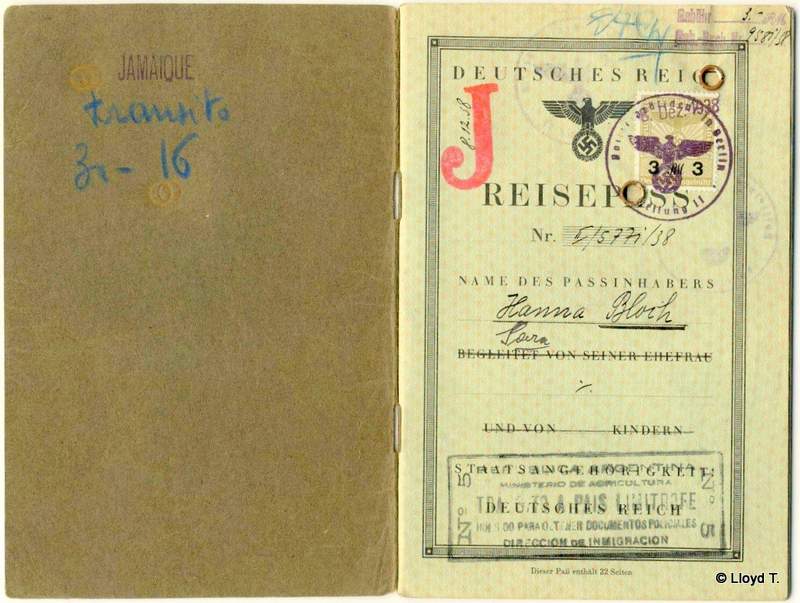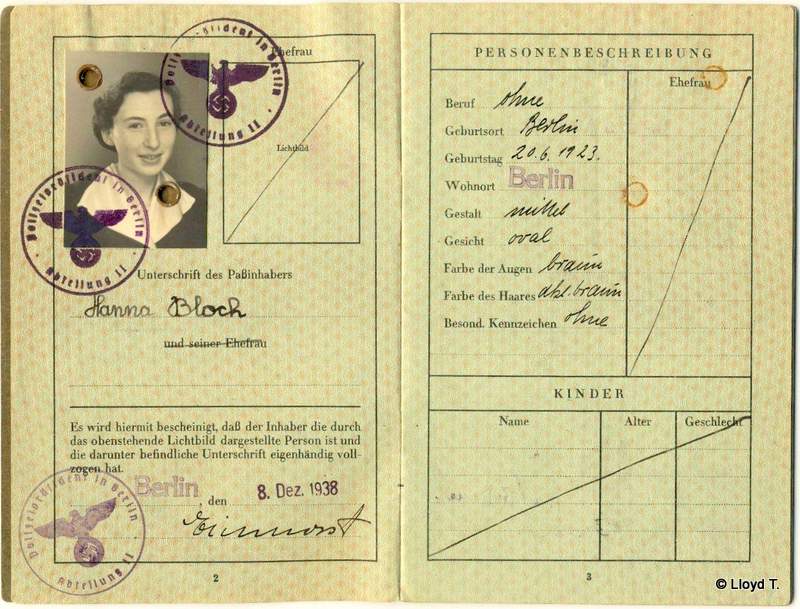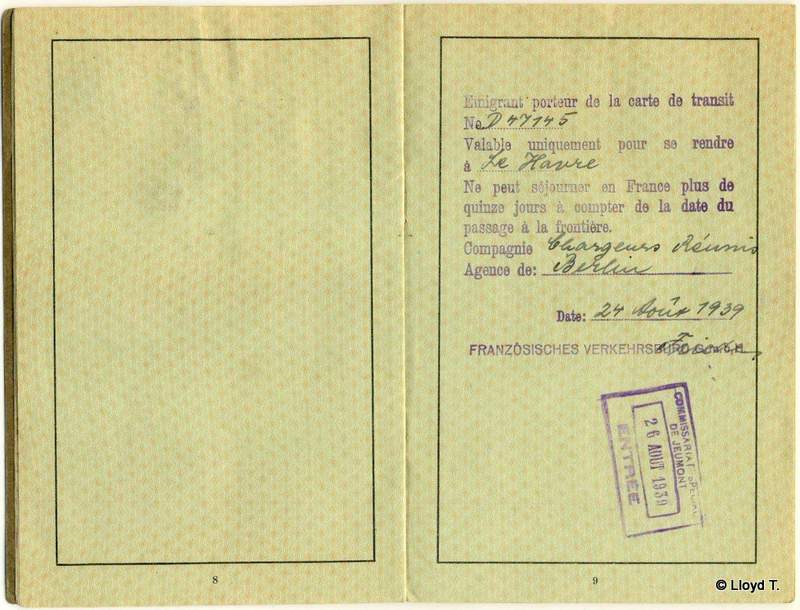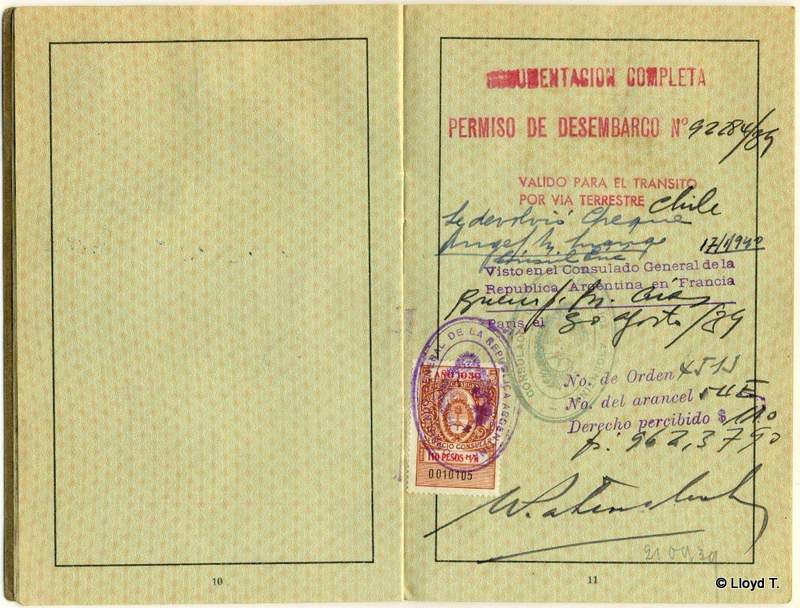German Jew fleeing to Domenican Republic 1938
German Jew fleeing to the Dominican Republic in 1938
A British reader contacted me about a passport he owns and wanted to know more details. He sent me pictures and to my surprise, I found besides other visas also a visa of the Dominican Republic issued at their consulate in Hamburg. It was the first visa Hanna Bloch obtained. Others are Chile, France (transit visa) and Argentina.
Jewish refugee via the Dominican Republic
When the world closed its borders at the Evian Conference 79 years ago (1938), one improbable nation stepped up to save a few hundred Jews from Nazi Germany: the Dominican Republic.
The Dominican Republic was one of the very few countries willing to accept mass Jewish immigration during World War II. At the Évian Conference, it offered to accept up to 100,000 Jewish refugees. The DORSA (Dominican Republic Settlement Association) was formed with the assistance of the JDC and helped settle Jews in Sosúa, on the northern coast. About 700 European Jews of Ashkenazi Jewish descent reached the settlement where each family received 33 hectares (82 acres) of land, 10 cows (plus 2 additional cows per children), a mule and a horse, and a US$10,000 loan (about 161,000 at 2016 prices) at 1% interest. Other refugees settled in the capital, Santo Domingo. In 1943 the number of known Jews in the Dominican Republic peaked at 1000. The Sosúa’s Jewish community experienced a deep decline in the 1980s due to emigration during the touristic boom of Sosúa when most Jews sold their land to developers at exorbitant prices. The oldest Jewish grave is dated to 1826. Today, there are approximately 100 Jews living in the Dominican Republic.
The Evian Conference, sponsored by US President Franklin D. Roosevelt to facilitate the resettlement of political refugees (in other words Jews) once the Nazi’s racial laws worsened the humanitarian condition in Europe. By 1938, discriminatory practices in Germany and Austria had given way to violent intimidation and sparked a refugee crisis.
The conference has been called, to paraphrase the Roman historian Sallust, “honest in the face but shameful in the heart.” Western Democracies across the globe shut their doors to Jews seeking asylum from the Nazi terrors in Europe, despite public expressions of sympathy by their governments at the horrors they were undergoing.
The United Kingdom, according to one diplomat present at Evian, declared that his island was “not a country of immigration,” and was “already sufficiently populated.” British colonies were deemed “inappropriate” for settlement, and Palestine at the time was off the table due to “local and political considerations [which] hinder or prevent any significant immigration,” according to “Dominican Haven” by Marion A. Kaplan.
France declared it had already reached its point of “saturation” regarding immigrants. Australians explained that because theirs was a relatively young country, they did not have a race problem and “were not desirous of introducing one.”
Industrial powers Canada and the United States, as well as needy developing countries Argentina and Brazil, found crafty reasons to not accept any refugees, despite expressing moral outrage at the situation. Some countries toyed with the idea of accepting refugees who were strict “agriculturists,” but that too never went further than conjecture.
The most germane observation regarding Evian came from Holocaust historian Henry Feingold, who lamented, “Representatives of the Jewish organizations despaired, as hope for immediate actions was drowned in a sea of Latin eloquence.”
The “hero” of Evian was not the revered Roosevelt, whose wife would come to be known as one of the greatest humanitarians of her time, but rather Generalissimo Rafael Trujillo, who ruled the Dominican Republic from 1930 to1961. Here was a man regarded by the rest of the world as an impersonal and violent dictator whose good deeds were fueled more by opportunism than statesmanship.
While Trujillo offered to absorb 100,000 refugees, only 800 received visas between 1940 and 1945. But neither the numbers nor his politics mattered much to the Jews who settled in Sosua.
The Passport
This should be one of the earliest Dominican Republic visa as it was already issued end of 1938. As just stated Jewish escape to this island was the exception, hence to find a German passport with the big Red J and such a visa is absolutely rare.
The passport is for a Jewish lady named Hanna Block. Born 20/6/23 and a resident of Berlin, issued on 8/12/38 and was valid for 1 year for travel at home and abroad. It bears various stamps, the most important one being a visa for the Dominican Republic showing the destination as Ciudad Trujillo.





The Sosúa Virtual Museum (http://www.sosuamuseum.org)
Thank you, Lloyd T. for bringing your outstanding collectible to my attention. Surely a significant document of Holocaust/Jewish (passport) history. Keep it safe!
German Jew fleeing to the Dominican Republic in 1938
FAQ Passport History
Passport collection, passport renewal, old passports for sale, vintage passport, emergency passport renewal, same day passport, passport application, pasaporte passeport паспорт 护照 パスポート جواز سفر पासपोर्ट
1. What are the earliest known examples of passports, and how have they evolved?
The word "passport" came up only in the mid 15th Century. Before that, such documents were safe conducts, recommendations or protection letters. On a practical aspect, the earliest passport I have seen was from the mid 16th Century. Read more...
2. Are there any notable historical figures or personalities whose passports are highly sought after by collectors?
Every collector is doing well to define his collection focus, and yes, there are collectors looking for Celebrity passports and travel documents of historical figures like Winston Churchill, Brothers Grimm, Johann Wolfgang von Goethe. Read more...
3. How did passport designs and security features change throughout different periods in history, and what impact did these changes have on forgery prevention?
"Passports" before the 18th Century had a pure functional character. Security features were, in the best case, a watermark and a wax seal. Forgery, back then, was not an issue like it is nowadays. Only from the 1980s on, security features became a thing. A state-of-the-art passport nowadays has dozens of security features - visible and invisible. Some are known only by the security document printer itself. Read more...
4. What are some of the rarest and most valuable historical passports that have ever been sold or auctioned?
Lou Gehrig, Victor Tsoi, Marilyn Monroe, James Joyce, and Albert Einstein when it comes to the most expensive ones. Read more...
5. How do diplomatic passports differ from regular passports, and what makes them significant to collectors?
Such documents were often held by officials in high ranks, like ambassadors, consuls or special envoys. Furthermore, these travel documents are often frequently traveled. Hence, they hold a tapestry of stamps or visas. Partly from unusual places.
6. Can you provide insights into the stories behind specific historical passports that offer unique insights into past travel and migration trends?
A passport tells the story of its bearer and these stories can be everything - surprising, sad, vivid. Isabella Bird and her travels (1831-1904) or Mary Kingsley, a fearless Lady explorer.
7. What role did passports play during significant historical events, such as wartime travel restrictions or international treaties?
During war, a passport could have been a matter of life or death. Especially, when we are looking into WWII and the Holocaust. And yes, during that time, passports and similar documents were often forged to escape and save lives. Example...
8. How has the emergence of digital passports and biometric identification impacted the world of passport collecting?
Current modern passports having now often a sparkling, flashy design. This has mainly two reasons. 1. Improved security and 2. Displaying a countries' heritage, icons, and important figures or achievements. I can fully understand that those modern documents are wanted, especially by younger collectors.
9. Are there any specialized collections of passports, such as those from a specific country, era, or distinguished individuals?
Yes, the University of Western Sidney Library has e.g. a passport collection of the former prime minister Hon Edward Gough Whitlam and his wife Margaret. They are all diplomatic passports and I had the pleasure to apprise them. I hold e.g. a collection of almost all types of the German Empire passports (only 2 types are still missing). Also, my East German passport collection is quite extensive with pretty rare passport types.
10. Where can passport collectors find reliable resources and reputable sellers to expand their collection and learn more about passport history?
A good start is eBay, Delcampe, flea markets, garage or estate sales. The more significant travel documents you probably find at the classic auction houses. Sometimes I also offer documents from my archive/collection. See offers... As you are already here, you surely found a great source on the topic 😉
Other great sources are: Scottish Passports, The Nansen passport, The secret lives of diplomatic couriers
11. Is vintage passport collecting legal? What are the regulations and considerations collectors should know when acquiring historical passports?
First, it's important to stress that each country has its own laws when it comes to passports. Collecting old vintage passports for historical or educational reasons is safe and legal, or at least tolerated. More details on the legal aspects are here...
Does this article spark your curiosity about passport collecting and the history of passports? With this valuable information, you have a good basis to start your own passport collection.
Question? Contact me...

